Chapter: Mechanical : Gas Dynamics and Jet Propulsion : Basic Concepts and Isentropic Flows
Basic Concepts and Isentropic Flows
Momentum Principle for
a Control Volume
For a finite control volume between Sections 1 and 2
the momentum principle is,

Where F is the x-component of resultant force
exerted on the fluid by the walls. Note that the momentum principle is
applicable even when there are frictional dissipative processes within
the control volume.
Stagnation Enthalpy
Suppose that our steady flow control volume is a set
of streamlines describing the flow up to the nose of a blunt object, as in
Figure
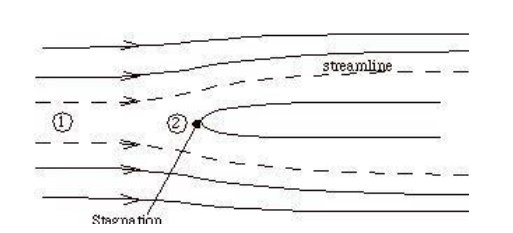
Streamlines and a stagnation region; a control
volume can be drawn between the dashed streamlines and points 1 and 2. The
streamlines are stationary in space, so there is no external work done on the
fluid as it flows. If there is also no heat transferred to the flow
(adiabatic),
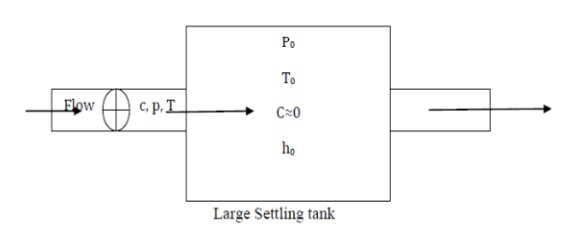
Stagnation enthalpy of a gas or vapor is its
enthalpy when it is adiabatically decelerated to zero velocity at zero
elevation.

Put,
Ø h1=h,
Ø c1=c
Ø for
the initial state h2=h0
Ø for
the final state c2=0
We have the
energy equation for
a nozzle and
diffuser is
By substituting this in above equation,

Where,
h0
=
Stagnation enthalpy h = Static enthalpy
c = Fluid velocity m / s
In an adiabatic energy transformation process the
stagnation enthalpy remain constant.
Stagnation Temperature
(or) Total temperature (T0)
Stagnation temperature of a gas when its
isentropically decelerated to zero velocity at zero elevation.
We know that, Stagnation enthalpy

We have stagnation enthalpy and static enthalpy for
a perfect gas is,
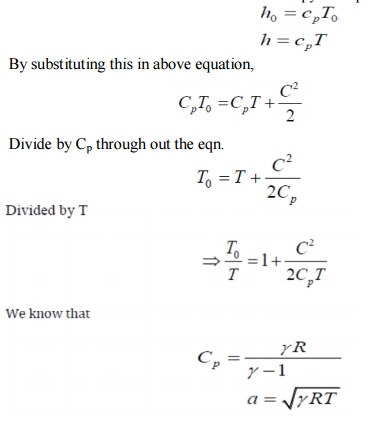
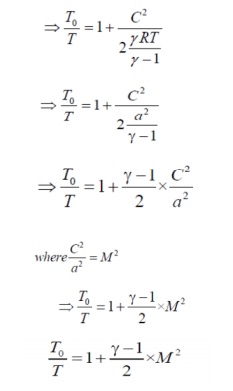
Divide by Cp through out the eqn.
Where
Ø To=
stagnation temperature
Ø T =
static temperature
Ø M =
Mach number (C/a)
Stagnation
Pressure, [Po] or total pressure
Stagnation pressure of a gas when it is
isentropically decelerated to zero velocity at zero elevation. For isentropic
flow.
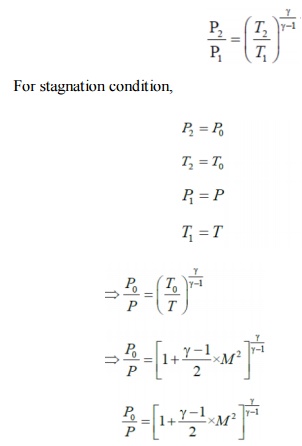
Stagnation velocity of sound
(ao):
We know that the acoustic velocity of sound

For a given value of Stagnation temperature,
Stagnation velocity of sound, For stagnation condition, Put, a a0 ,
T T0
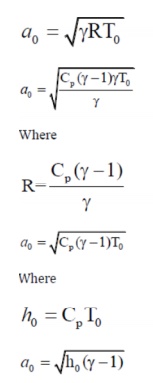

Various regions of flow
The adiabatic energy
equation for a perfect gas is derived in terms of velocity of fluid(C) and
Velocity of sound ao
We have stagnation enthalpy and static enthalpy for
a perfect gas is h0 cpT0

Flow Regime Classification
Ø Subsonic
Flow (0.8 < Mo)
Ø Transonic
Flow (0.8 > M0 > 1.2)
Ø Supersonic
Flow (M0 > 1.2)
Ø Hypersonic
Flow (M0 > 5)
Ø Incompressible
region
In incompressible flow
region fluid velocity (c) is much smaller than the sound velocity (a).
Therefore the Mach number (M = c/a) is very low. Eg: flow through nozzles
Ø Subsonic
flow region
The
subsonic flow region is on the right of the incompressible flow region. In
subsonic flow, fluid velocity (c) is less than the sound velocity (a) and the
Mach number in this region is always less than unity.
i.e. M = c a 1.
Eg: passenger air craft
Ø Sonic
flow region
If
the fluid velocity (c) is equal to the sound velocity (a), that type of flow is
known as sonic flow. In sonic flow Mach number value is unity.
M = c a = 1 c a.
Eg: Nozzle throat
Ø Transonic
flow region
If
the fluid velocity close to the speed of sound, that type of flow is known as
transonic flow .In transonic flow, Mach number value is in between 0.8 and 1.2.
i.e.0.8 < M < 1.2.
Ø Supersonic
flow region
The
supersonic region is in the right of the transonic flow region. In supersonic
flow, fluid velocity (c) is more than the sound velocity (a) and the Mach
number in this region is always greater than unity.
i.e. M = c/a >1.Eg:
military air crafts
Hypersonic flow region
In
hypersonic flow region, fluid velocity (c) is much greater than sound velocity
(a).In this flow, Mach number value is always greater than 5.
i.e.
M = c/a >5. Eg: rockets
Reference Velocities
In
compressible flow analysis it is often convenient to express fluid velocities
is non dimensional forms.
Ø
Local velocity of sound
Ø
Stagnation velocity of sound
Ø
Maximum velocity of fluid
Ø
Critical velocity of fluid/sound. C*=a*
1.Maximum
velocity of fluid:
From adiabatic energy equation has two components of
the total energy: the enthalpy h and the kinetic energy .If kinetic energy is
absent the total energy is entirely energy represented by the stagnation
enthalpy h0 .the other extreme conditions which can be conceived is when the
entire energy is made up of kinetic energy only=0 and C = Cmax. The
fluid velocity (Cmax) corresponding to this condition is the maximum
velocity that would be achieved by the fluid when it is accelerated to absolute
zero temperature (T = 0, T = 0) in an imaginary adiabatic expansion process.
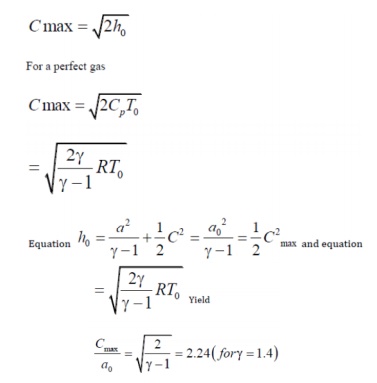
2 Critical velocity of
sound
It is the velocity of flow that would exist if the
flow is isentropically accelerated or decelerated to unit Mach number (critical
condition).
We have
Considering the *section (where M = 1) and its
stagnation section M 1
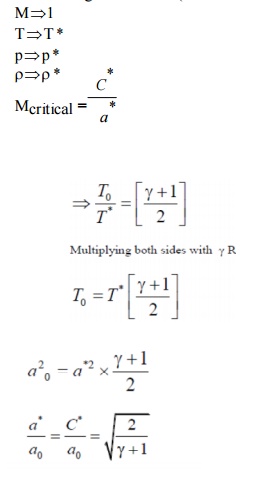
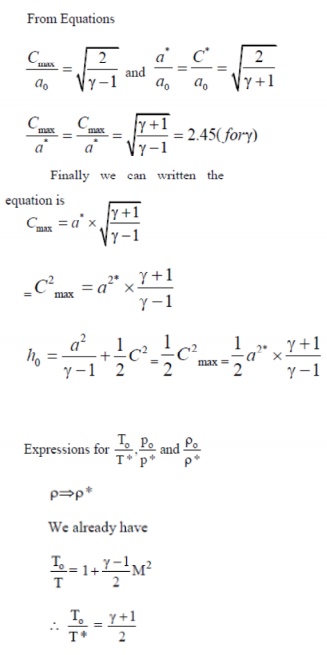
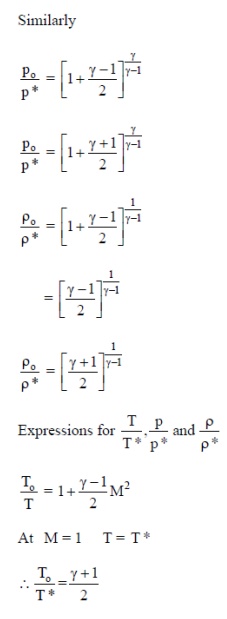
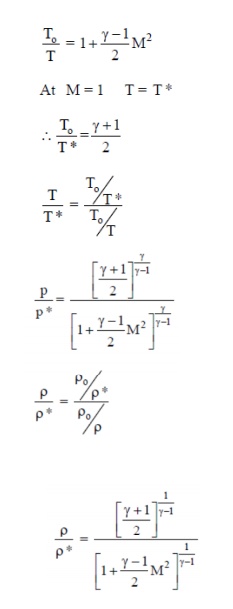
Mach number
In fluid mechanics, Mach number (M or Ma) is a
dimensionless quantity representing the ratio of speed of an object moving
through a fluid and the local speed of sound.

Mach Cone
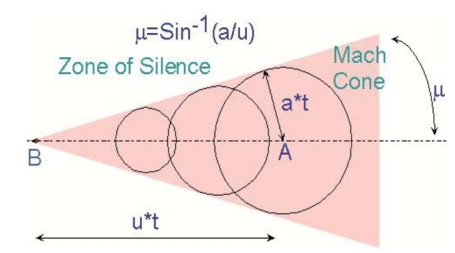
A conical surface that bounds the region in a
supersonic flow of gas in which the sound waves (perturbations) emanating from
a point source A of the perturbations are concentrated.
Reference Mach number M*
In the analysis of high speed flows, another Mach
number called M*is employed. It is defined as the non
dymensionlizing the fluid velocity by the critical fluid velocity or the sound
velocity.
That is,
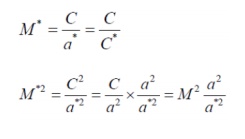
Some it is more
convenient to use M* instead of M because
(i) at
high fluid velocities M approaches infinity
(ii) M
is not proportional to the velocity alone
It should be pointed out here that M*does
not mean M = 1this only other type of Mach number.
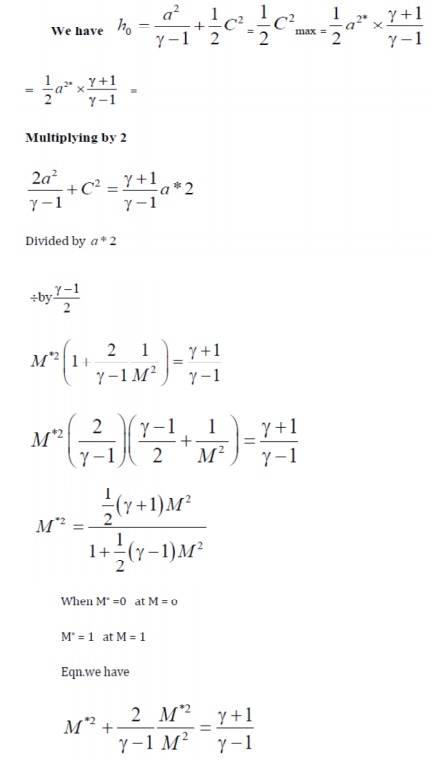

Crocco number
A non -dimensional fluid velocity can be defined by
using the Maximum fluid velocity,
Isothermal Flow
Ø Adiabatic
and Reversible.
Ø No
energy added, No energy losses.
Ø Small
and gradual change in flow variables.
The earliest reference to is other mal flow was
found in Shapiro’s Book. The model Suggests that the choking occurs at 1 /√kanditappearsthatShapirowasthefirstoneto
realize this difference compared to the other models. In reality, the flow is
choked somewhere between 1 Root of k to one for cases that are between Fanno
(adiabatic) and isothermal flow. This fact was evident in industrial
applications where the expectation of the choking is at Mach one, but can be
explained by choking at a lower Mach number. No experimental evidence, known by
the undersigned, was ever produced to verify this finding.
Law of conservation of momentum
(Newton’s
Second Law) Law of conservation of momentum to a system
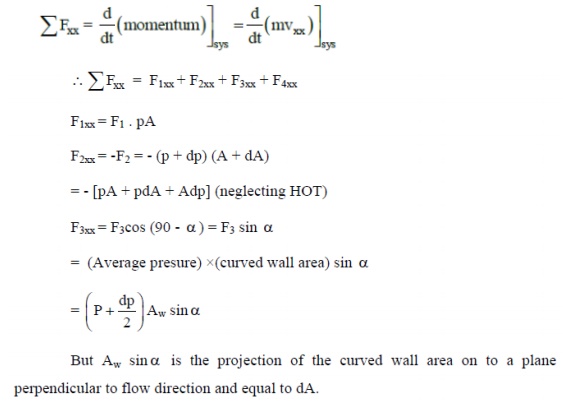
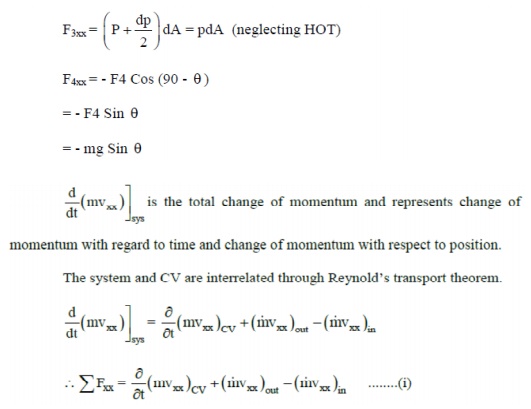
Assumptions
Ø
1 - D flow
Ø
Steady flow
Ø
Higher order terms (Hot’s) are neglected
Ø
The fluid is invicid (M = 0)
Ø
Compressible fluid
Fxx - This
represents the summation of all forces acting on CV and includes surface and
body forces. Surface forces are of normal and tangential forms. Since the fluid
is invicid shear force (tangential) = 0
Figure above shows a flow through CV. All fluid
properties at inlet and exit are represented. Various forces act ing are also
represented in their respective direction at the appropriate locations.
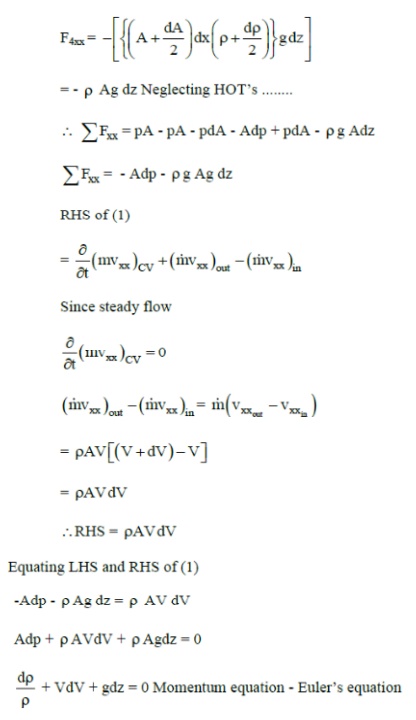
Problems
1)
Atm air at 1.1×105 N/m2 and 65oC is
accelerated isentropically to a mach number of 1.
Find
final temp, pressure and flow velocity.
Ans.Assume,
the given state is the stagnation state, From data book, is entropic table, K =
1.4
T = T* = 8.834 × To = 0.834 × 338
T
= 281.9 K
Final
temperature T* = 281.9 K
P
= P* = Po × 0.528
=
1.1 × 105 × 0.528
0.581 × 105 N/m2
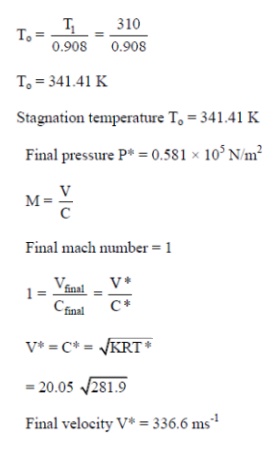
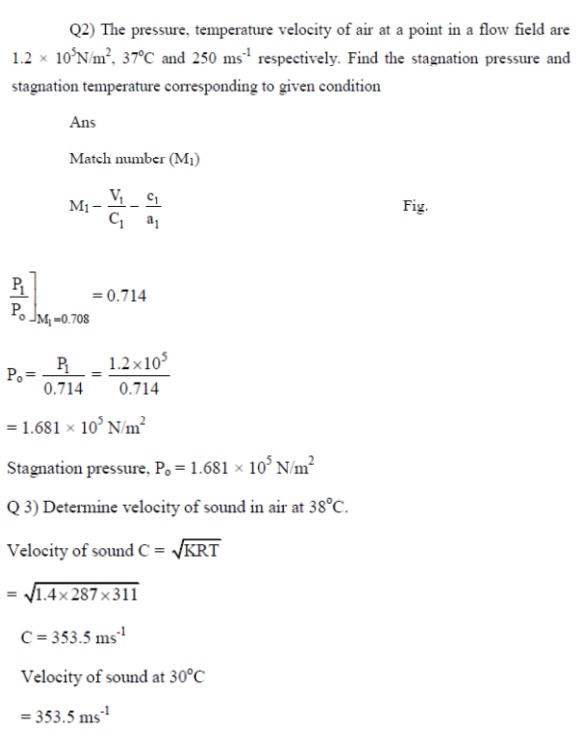
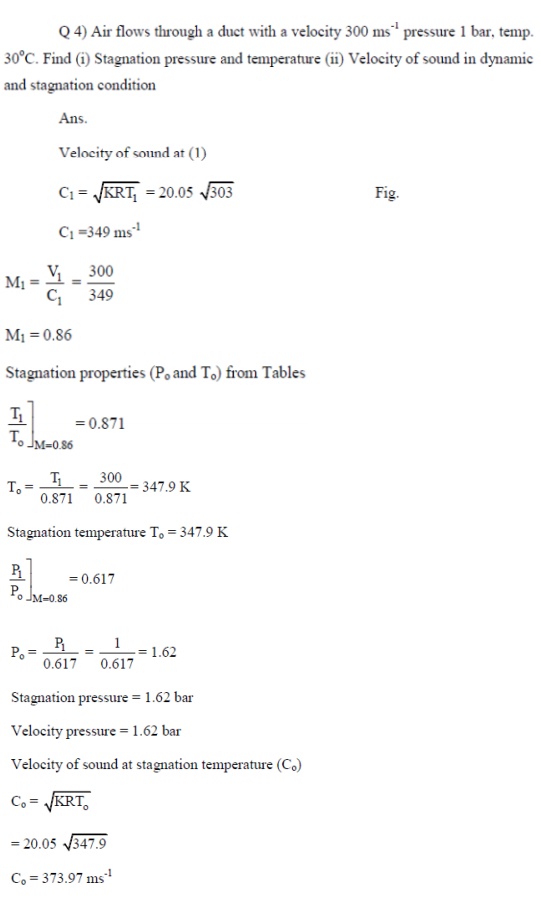

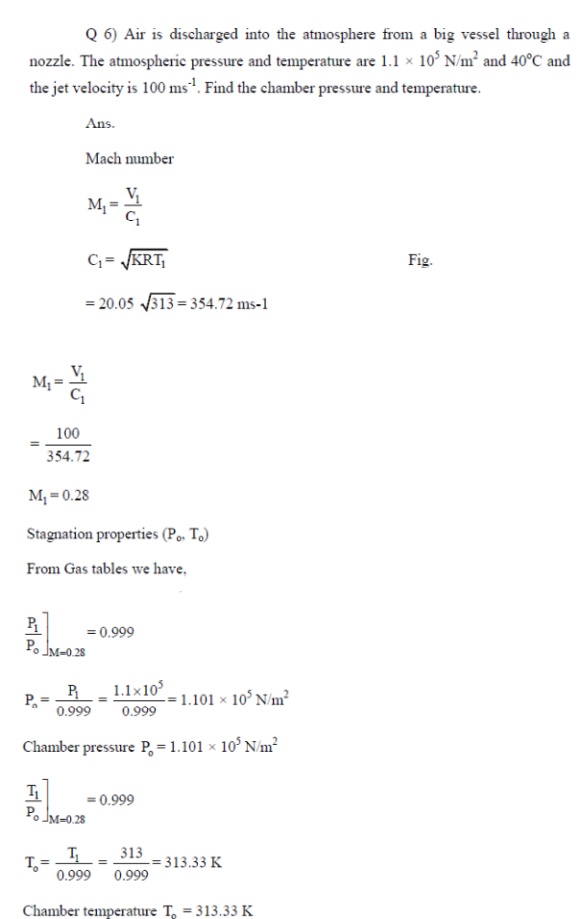
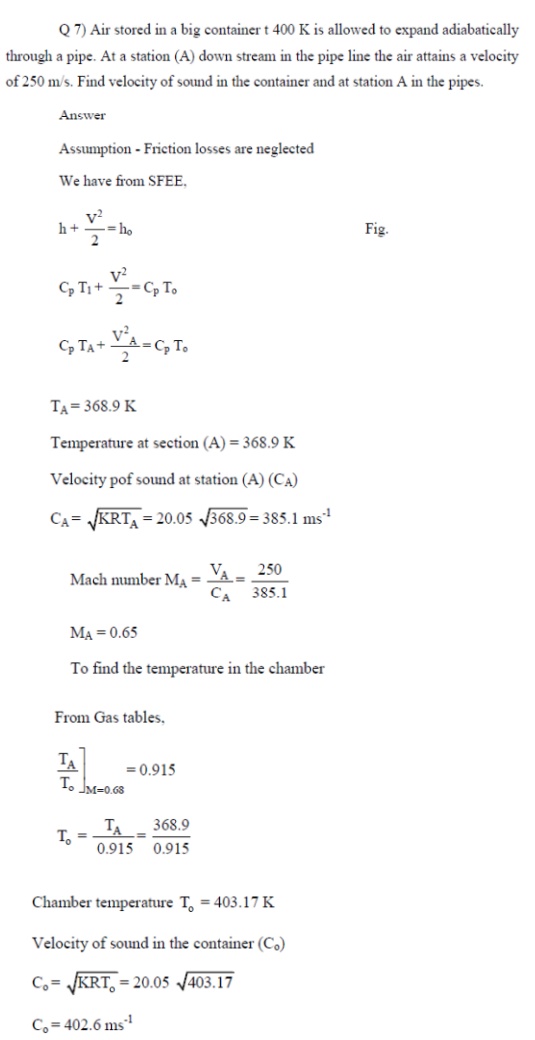
Flow through Nozzles
A nozzle is a duct that increases the velocity of
the flowing fluid at the expense of pressure drop. A duct which decreases the
velocity of a fluid and causes a corresponding increase in pressure is a
diffuser. The same duct may be either a nozzle or a diffuser depending upon the
end conditions across it. If the cross-section of a duct decreases gradually
from inlet to exit, the duct is said to be convergent. Conversely if the cross
section increases gradually from the inlet to exit, the duct is said to be
divergent. If the cross-section initially decreases and then increases, the
duct is called a convergent-divergent nozzle. The minimum cross-section of such
ducts is known as throat. A fluid is said to be compressible if its density
changes with the change in pressure brought about by the flow. If the density
does not changes or changes very little, the fluid is said to be
incompressible. Usually the gases and vapors are compressible, whereas liquids
are incompressible.
Nozzle:
A nozzle is primarily used to increase the flow
velocity.
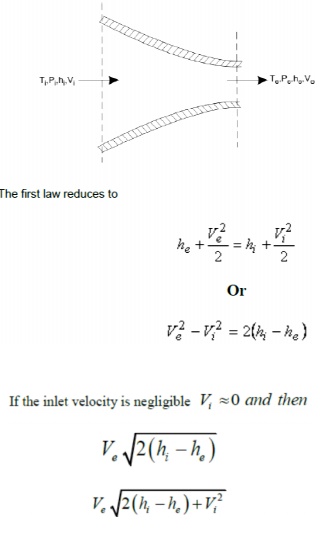
The velocity is increased at the cost of drop in enthalpy. If an ideal gas is flowing through the nozzle, the exit velocity Ve can be expressed in terms of inlet and outlet pressure and temperatures by making use of the relations
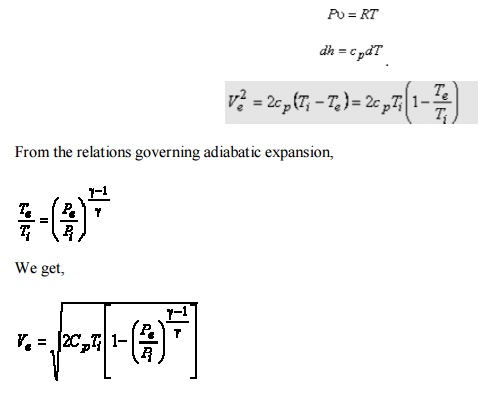
Diffuser:
A diffuser can be thought of as a nozzle in which
the direction of flow is reversed.
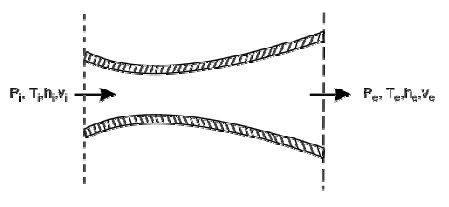
For an adiabatic diffuser, Q and Wsh are zero and
the first law reduces to
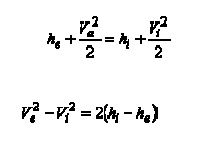
The diffuser
discharges fluid with higher enthalpy. The velocity of the fluid is reduced.
Ø
Example of a reversible process:
– Slow compression of air in a balloon does work on
the air inside the balloon, and takes away energy from the surroundings - When
the balloon is allowed to expand, the air inside and the surrounding air are
both restored to original conditions
Example
of an irreversible process:
Heat flows from hot to cold, never in the opposite
direction; Most conductive and viscous processes are irreversible Stagnation
point is thus when fluid is brought to stagnant state (eg, reservoir)
Stagnation properties can be obtained at any point
in a flow field if the fluid at that point were decelerated from local
conditions to zero velocity following an isentropic (frictionless, adiabatic)
process
Pressure: p0
Temperature: T0
Density: ρ0
Ø
If a fluid were brought to a complete
stop (C 2 = 0)
Ø
Therefore, h0 represents the
enthalpy of a fluid when it is brought to rest adiabatically.
Ø
During a stagnation process, kinetic
energy is converted to enthalpy.
Ø
Properties at this point are called stagnation
properties (which are identified by subscript 0)
If the process is also
reversible, the stagnation state is called the isentropic stagnation
state.
Stagnation enthalpy is the same for isentropic and
actual stagnation states
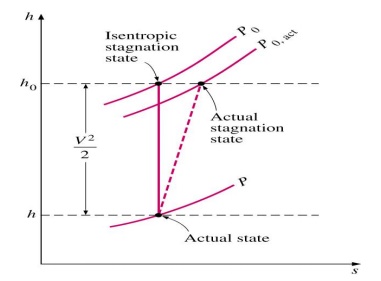
Actual stagnation pressure P0,act is lower
than P0 due to increase in entropy s as a result of fluid
friction. Nonetheless, stagnation processes are often approximated to be
isentropic, and isentropic properties are referred to as stagnation properties
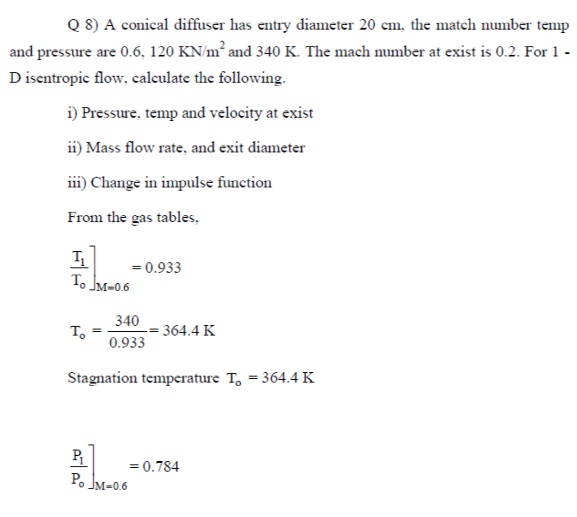

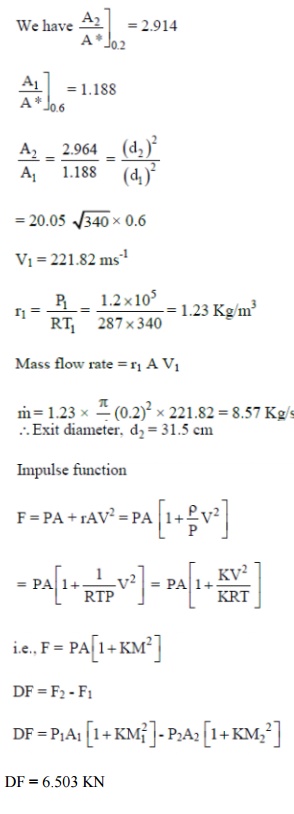
Q
9) Air is discharged from a reservoir at Po = 6.91 Kgf/cm2and to =
325oC through a nozzle to an exit pressure of 0.98 Kgf/cm2
. If the flow rate is 1 kg/s, find the throat area, pressure and velocity. Also
find the exit area, exit temperature and exit velocity.
Ans
Exit Mach number Me]
= 1.93
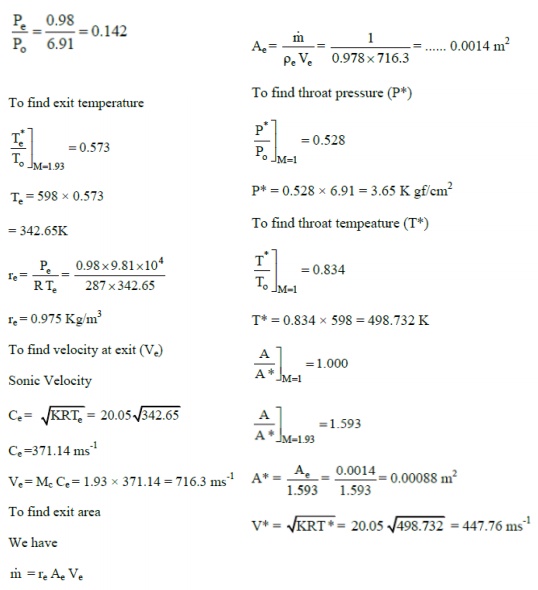
Q
10) Air flows isentropically through a C.D. The inlet conditions are pressure
700 KN/m2, temperature 320oC, velocity 50 m/s. The exit
pressure is 105KN/m2 and the exist area is 6.25 cm2.
Calculate
i)
Mach number, temperature and velocity at
exit
ii)
Pressure, temperature and velocity at
throat
iii)
Mass flow rate
iv)
Throat area
Ans:
To find the exit mach number (M2)
Sonic velocity at inlet
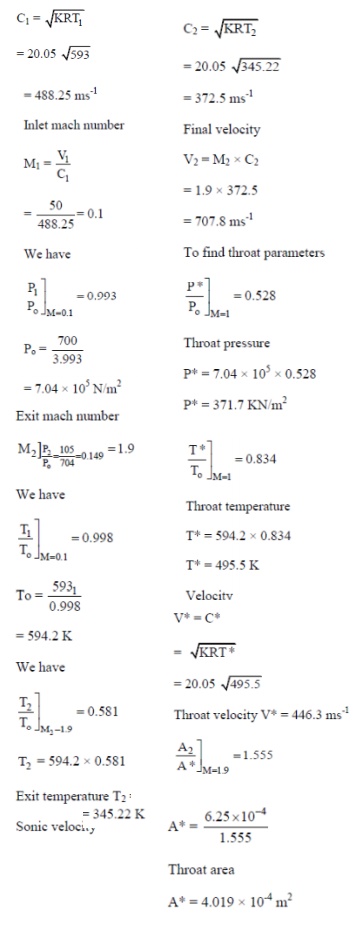
Tutorial Problems:
1.The
pressure, temperature and Mach number at the entry of a flow passage are 2.45
bar, 26.5° C and 1.4 respectively. If the exit Mach number is 2.5 determine for
adiabatic flow of perfect gas (γ =1.3, R=0.469 KJ/Kg K).
2.
Air flowing in a duct has a velocity of 300 m/s ,pressure 1.0 bar and
temperature 290 k. Taking γ=1.4 and R =287J/Kg K determine: 1) Stagnation
pressure and temperature, 2) Velocity of sound in the dynamic and stagnation
conditions, 3) Stagnation pressure assuming constant density.
3.
A nozzle in a wind tunnel gives a test –section Mach number of 2.0 .Air enters
the nozzle from a large reservoir at 0.69 bar and 310 k .The cross –sectional
area of the throat is1000cm²
.Determine
the following quantites for the tunnel for one dimensional isentropic flow 1)
Pressures,temperature and velocities at the throat and test sections, 2) Area
of cross- sectional of the test section , 3) Mass flow rate, 4) Power rate
required to drive the compressor.
4.Air
is discharged from a reservoir at Po =6.91bar and To =325°c through a nozzle to
an exit
pressure of 0.98 bar .If the flow rate is 3600Kg/hr
determine for isentropic flow: 1)Throat area, pressure,and velocity, 2)Exit
area,Mach number ,and 3)Maximum velocity.
5.Air flowing in a duct has a velocity
of 300 m/s ,pressure 1.0 bar and temperature 290 K. Taking γ=1.4 and R =287J/Kg
K determine: 1)Stagnation pressure and temperature, 2)Velocity
of
sound in the dynamic and stagnation conditions 3)Stagnation pressure assuming
constant density.
6.A
conical diffuser has entry and exit diameters of 15 cm and 30cm respectively.
Pressure ,temperature and velocity of air at entry are 0.69bar,340 k and 180
m/s respectively . Determine 1) The exit pressure, 2) The exit velocity and 3)
The force exerted on the diffuser walls.Assume isentropic flow,γ =1.4,Cp =1.00
KJ Kg-K
Related Topics